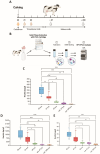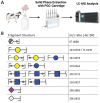Structural Characterization and Abundance of Sialylated Milk Oligosaccharides in Holstein Cows during Early Lactation
- PMID: 39200411
- PMCID: PMC11353935
- DOI: 10.3390/foods13162484
Structural Characterization and Abundance of Sialylated Milk Oligosaccharides in Holstein Cows during Early Lactation
Abstract
Among other bioactive molecules, milk contains high amounts of sialylated milk oligosaccharides (MOs) that influence numerous processes in the offspring. For instance, sialylated MOs inhibit the invasion of pathogens and positively influence the gut microbiome to support the optimal development of the offspring. For these reasons, sialylated MOs are also used in infant formula as well as food supplements and are potential therapeutic substances for humans and animals. Because of the high interest in sialylated bovine MOs (bMOs), we used several analytical approaches, such as gas and liquid chromatography in combination with mass spectrometry, to investigate in detail the profile of sialylated bMOs in the milk of Holstein Friesian cows during early lactation. Most of the 40 MOs identified in this study were sialylated, and a rapid decrease in all detected sialylated bMOs took place during the first day of lactation. Remarkably, we observed a high variance within the sialylation level during the first two days after calving. Therefore, our results suggest that the content of sialylated MOs might be an additional quality marker for the bioactivity of colostrum and transitional milk to ensure its optimized application for the production of milk replacer and food supplements.
Keywords: bovine milk; colostrum; lactation; milk oligosaccharides; sialic acids; sialyllactose.
Conflict of interest statement
The authors declare no conflicts of interest.
Figures








Similar articles
-
Characterization of the milk oligosaccharide spectrum in water buffaloes during early lactation.Carbohydr Polym. 2025 Nov 1;367:123930. doi: 10.1016/j.carbpol.2025.123930. Epub 2025 Jun 23. Carbohydr Polym. 2025. PMID: 40817464
-
Analysis of the biosynthetic flux in bovine milk oligosaccharides reveals competition between sulfated and sialylated species and the existence of glucuronic acid-containing analogues.Food Chem. 2021 Nov 1;361:130143. doi: 10.1016/j.foodchem.2021.130143. Epub 2021 May 18. Food Chem. 2021. PMID: 34051596
-
Neutral and acidic oligosaccharides in Holstein-Friesian colostrum during the first 3 days of lactation measured by high performance liquid chromatography on a microfluidic chip and time-of-flight mass spectrometry.J Dairy Sci. 2010 Sep;93(9):3940-9. doi: 10.3168/jds.2010-3156. J Dairy Sci. 2010. PMID: 20723667 Free PMC article.
-
Functional role and mechanisms of sialyllactose and other sialylated milk oligosaccharides.Nutr Rev. 2014 Jun;72(6):377-89. doi: 10.1111/nure.12106. Epub 2014 May 14. Nutr Rev. 2014. PMID: 24828428 Review.
-
Potential biological functions and future perspectives of sialylated milk oligosaccharides.Arch Pharm Res. 2024 Apr;47(4):325-340. doi: 10.1007/s12272-024-01492-3. Epub 2024 Apr 1. Arch Pharm Res. 2024. PMID: 38561494 Review.
References
LinkOut - more resources
Full Text Sources

